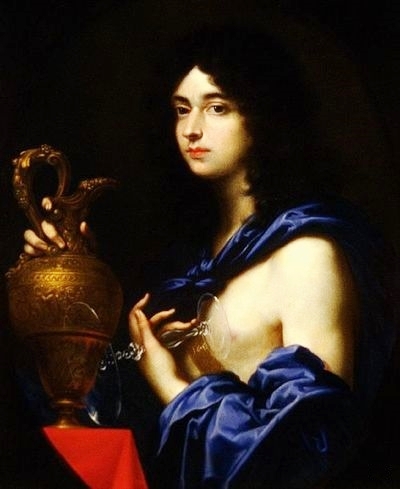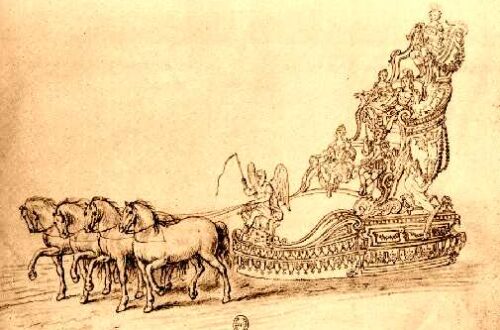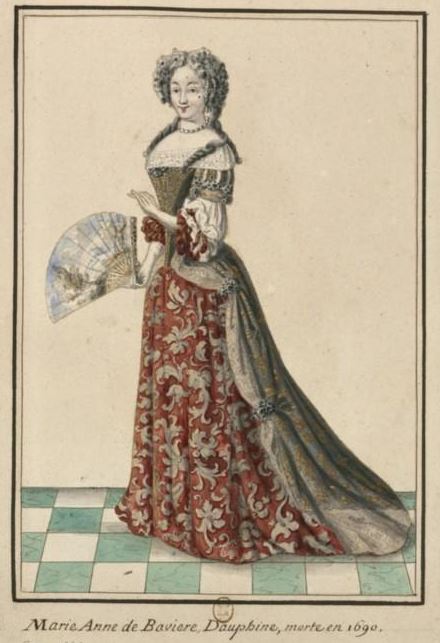The Black Nun of Moret
There are many interesting tales that once circulated at the court of Louis XIV in form of juicy gossip and this one is especially juicy by all means. It is the tale of a dark skinned nun confined in a convent with the name Louise-Marie-Thérèse. Now, that isn’t too unusual by itself, but have a closer look at her name and you might see where this story goes… Louise-Marie-Thérèse, Louise as in the female form of Louis, and Marie-Thérèse, the very name of the Queen of France.
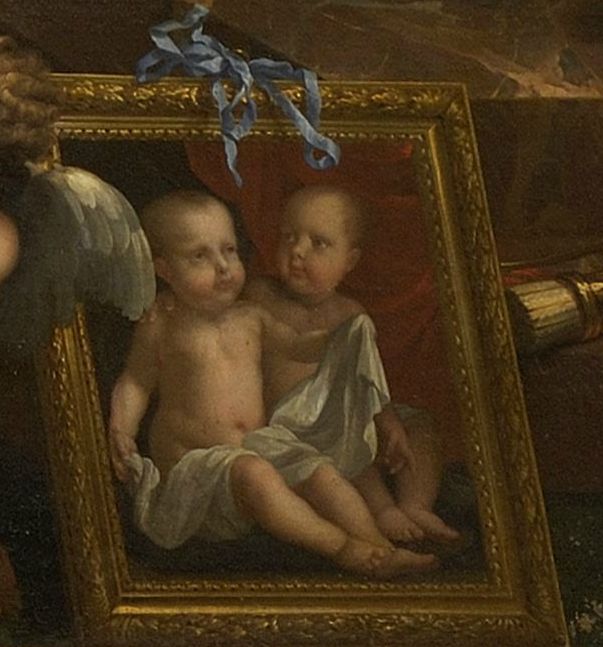
Marie-Thérèse and Louis XIV were married for four years as the Queen gave birth to a daughter on 16 November in 1664, one month prematurely. This took place at the Louvre and in presence of half the court. The child was baptised as Marie-Anne de France and died shortly after on 26 December the same year. Marie-Anne was the second daughter and third child of Louis XIV and his Spanish born Queen Marie-Thérèse, and just like her 1662 born sister Anne-Élisabeth, she lived only a few days.
There were some voices over the years, however, who claimed the child did not die and it was just a story to distract everyone from what really happened. References of this can be found in a sentence La Grande Mademoiselle wrote, and again in Saint-Simon‘s memoirs and in those attributed to Madame de Montespan.
Here is what happened according to this juicy piece of gossip…
The Queen gave birth to a black child fathered by a African dwarf named Nabo. Having a personal servant of small size by one’s side was at this time considered a la mode and the thing to have and show off. It was something exotic and extremely fashionable. Nabo was one of the first and the Queen’s close companion. A bit too close perhaps…
Our titillating titbit continues with the Queen giving birth to a child of dark skin, much to the surprise of everyone, apart from Nabo perhaps, and the child being taken away. The court was told it died and a funeral was prepared and acted out, while the child was given into the hands of Monsieur Alexandre Bontemps, the King’s first valet, and taken away to be placed in a convent some time after, where she took the veil in 1695.
A portrait of this black nun exists at the Bibliothèque Sainte Geneviève in Paris and is thought to have been painted by the same hand which painted the series of twenty-two pastel portraits of Kings of France, from Louis IX to Louis XIV, between 1681 to 1683 on the initiative of Father Claude Du Molinet.
The nun herself is said to be born in 1664, the same year as Marie-Anne de France, and apparently was quite sure of her her royal birth.
Saint-Simon, who never saw her in person, nor was alive at the time of her birth, mentions the following in his memoirs: “People were astonished this year, that while the Princess of Savoy was at Fontainebleau, just before her marriage, she was taken several times by Madame de Maintenon to a little unknown convent at Moret, where there was nothing to amuse her, and no nuns who were known. Madame de Maintenon often went there, and Monseigneur with his children sometimes; the late Queen used to go also. This awakened much curiosity and gave rise to many reports. It seems that in this convent there was a woman of colour, a Moorish woman, who had been placed there very young by Bontems, valet of the King. She received the utmost care and attention, but never was shown to anybody. When the late Queen or Madame de Maintenon went, they did not always see her, but always watched over her welfare. She was treated with more consideration than people the most distinguished; and herself made much of the care that was taken of her, and the mystery by which she was surrounded. Although she lived regularly, it was easy to see she was not too contented with her position. Hearing Monseigneur hunt in the forest one day, she forgot herself so far as to exclaim, “My brother is hunting!” It was pretended that she was a daughter of the King and Queen, but that she had been hidden away on account of her colour; and the report was spread that the Queen had had a miscarriage. Many people believed this story; but whether it was true or not has remained an enigma.”
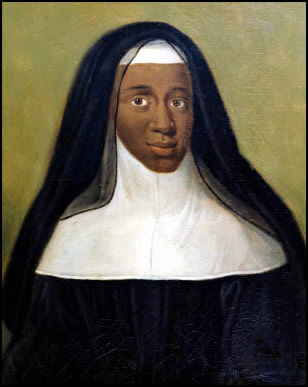
There is another mention of her in the memoirs attributed to Madame de Montespan, but which were most likely not written by herself, but by Abbé Philippe Musoni and published in 1829:
“I have already told how the envoys of the King of Arda, an African prince, gave to the Queen a nice little blackamoor, as a toy and pet.This Moor, aged about ten or twelve years, was only twenty-seven inches in height, and the King of Arda declared that, being quite unique, the boy would never grow to be taller than three feet. The Queen instantly took a great fancy to this black creature. Sometimes he gambolled about and turned somersaults on her carpet like a kitten, or frolicked about on the bureau, the sofa, and even on the Queen’s lap. As she passed from one room to another, he used to hold up her train, and delighted to catch hold of it and so make the Queen stop short suddenly, or else to cover his head and face with it, for mischief, to make the courtiers laugh. He was arrayed in regular African costume, wearing handsome bracelets, armlets, a necklace ablaze with jewels, and a splendid turban. Wishing to show myself agreeable, I gave him a superb aigrette of rubies and diamonds; I was always sorry afterwards that I did so. The King could never put up with this little dwarf, albeit his features were comely enough. To begin with, he thought him too familiar, and never even answered him when the dwarf dared to address him. Following the fashion set by her Majesty, all the Court ladies wanted to have little blackamoors to follow them about, set off their white complexions, and hold up their cloaks or their trains. Thus it came that Mignard, Le Bourdon, and other painters of the aristocracy, used to introduce negro boys into all their large portraits. It was a mode, a mania; but so absurd a fashion soon had to disappear after the mishap of which I am about to tell. The Queen being pregnant, public prayers were offered up for her according to custom, and her Majesty was forever saying: “My pregnancy this time is different from preceding ones. I am a prey to nausea and strange whims; I have never felt like this before. If, for propriety’s sake, I did not restrain myself, I should now dearly like to be turning somersaults on the carpet, like little Osmin. He eats green fruit and raw game; that is what I should like to do, too. I should like to–” “Oh, madame, you frighten us!” exclaimed the King. “Don’t let all those whimsies trouble you further, or you will give birth to some monstrosity, some freak of nature.” His Majesty was a true prophet. The Queen was delivered of a fine little girl, black as ink from head to foot. They did not tell her this at once, fearing a catastrophe, but persuaded her to go to sleep, saying that the child had been taken away to be christened.
The physicians met in one room, the bishops and chaplains in another. One prelate was opposed to baptizing the infant; another only agreed to this upon certain conditions. The majority decided that it should be baptized without the name of father or mother, and such suppression was unanimously advocated. The little thing, despite its swarthy hue, was most beautifully made; its features bore none of those marks peculiar to people of colour. It was sent away to the Gisors district to be suckled as a negro’s daughter, and the Gazette de France contained an announcement to the effect that the royal infant had died, after having been baptised by the chaplains.
The little African was sent away, as may well be imagined; and the Queen admitted that, one day soon after she was pregnant, he had hidden himself behind a piece of furniture and suddenly jumped out upon her to give her a fright. In this he was but too successful. The Court ladies no longer dared come near the Queen attended by their little blackamoors. These, however, they kept for a while longer, as if they were mere nick-hacks or ornaments; in Paris they were still to be seen in public. But the ladies’ husbands at last got wind of the tale, when all the little negroes disappeared.”
La Grande Mademoiselle wrote a sentence mentioning the matter as well. She was not present herself at the birth, but was shortly after informed of it by Monsieur, her cousin and the King’s brother: “Monsieur told me … that the baby girl, which she [the Queen] had given birth to, resembled a small Moor that Monsieur de Beaufort had brought, who was very pretty, the one who was always with the queen; that when it was remarked that her baby resembled [the Moor], he was removed; that the little girl was horrible; that she would not live; that I must take care not to say so to the queen, nor that [the baby] would die.”
In contrary to Saint-Simon, la Grande Mademoiselle was actually alive at the time of the birth and unlike the memoirs of Madame de Montespan, there is no doubt that those of the Grande Mademoiselle were written by herself. This might be the strongest evidence on the matter we have.
Fact is, the Queen gave birth to a girl in 1664 and that one month prematurely, this child was apparently hairy, deformed and of a darker tone of skin. The Queen herself was Spanish, which might explain the darker tone of skin, but it also could have been caused by lack of oxygen during the birth. The dark tone of skin might have been more a blue or violet instead of a black. The girl’s birth and death were witnessed by many, which makes it unlikely she has been secretly brought away to be raised somewhere else. There are mentions of the child being very ugly, along with the supposed dark tone of skin, it could link to the African dwarf, who most likely did not have what was considered handsome proportions.
Whichever story is true, we can only speculate about it. It is just as likely that our black nun made the story up and it spread slowly. A black nun was rather unusual at the time and she might have used this fact to gain more importance. It could have reached the ears of the courtiers, who were always eager for the latest gossip, and spread to the point of it being put onto parchment by Saint-Simon, who was quite the gossiper himself.
